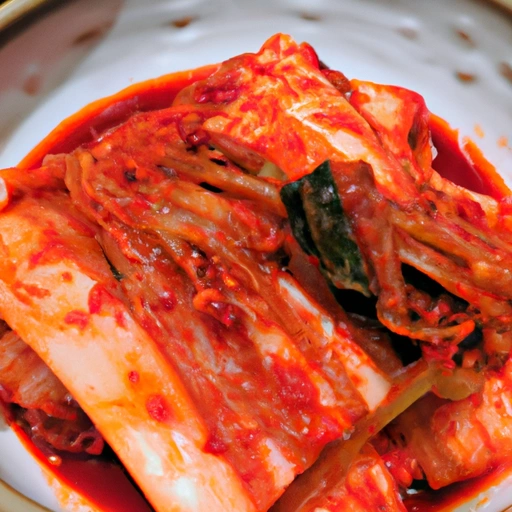Kimchi
Description

Kimchi is a traditional Korean side dish made from fermented vegetables, most commonly Napa cabbage and Korean radishes, with a variety of seasonings including chili powder, garlic, ginger, and jeotgal (salted seafood). It is known for its distinctive spicy and sour taste and is a staple in Korean cuisine. Kimchi has gained international fame, not only for its unique flavor profile but also for its health benefits.
Common uses
Kimchi is typically eaten on its own or with rice, but it is also used in a variety of Korean dishes such as kimchi jjigae (kimchi stew), kimchi bokkeumbap (kimchi fried rice), and kimchi jeon (kimchi pancake). Its versatility has allowed it to be incorporated into non-traditional dishes, such as sandwiches, burgers, and pizzas.
Nutritional value
Calories
Approximately 23 calories per 100 grams (3.5 oz).
Protein
Contains about 2 grams of protein per 100 grams (3.5 oz).
Fat
Kimchi is low in fat, with less than 1 gram of fat per 100 grams (3.5 oz).
Carbohydrates
Approximately 4-5 grams of carbohydrates per 100 grams (3.5 oz).
Vitamins
Rich in vitamins A, B, and C.
Minerals
Contains minerals such as potassium, calcium, and magnesium.
Health benefits
Kimchi is packed with probiotics due to the fermentation process, which contributes to a healthy gut microbiome. It is also high in dietary fiber, which aids in digestion. The capsaicin in the chili peppers used in kimchi is known to boost metabolism and may aid in weight loss. Additionally, the antioxidants present in kimchi can help reduce inflammation and lower the risk of chronic diseases.
Potential risks
While kimchi is healthy overall, it can be high in sodium, which may not be suitable for individuals with high blood pressure or those on a low-salt diet. Due to fermentation, it can also contain a high level of histamines, which can trigger symptoms in people with histamine intolerance.
Common recipes
Kimchi can be used in a variety of recipes ranging from traditional Korean dishes to modern culinary creations. Some popular recipes include kimchi stew, kimchi fried rice, and kimchi pancakes.
Cooking methods
Kimchi can be eaten raw, cooked as an ingredient in stews and stir-fries, or used as a flavorful condiment.
Pairing with other ingredients
Kimchi pairs well with steamed rice, grilled meats, and can also complement the flavors in fusion dishes such as tacos or grilled cheese sandwiches.
Summary
Kimchi is a versatile and flavorful ingredient that not only enhances the taste of various dishes but also offers numerous health benefits. Its global popularity continues to grow as more people discover its unique taste and nutritional advantages. Incorporating kimchi into your diet can be an excellent way to explore the depths of Korean cuisine while enjoying a healthy, probiotic-rich food.